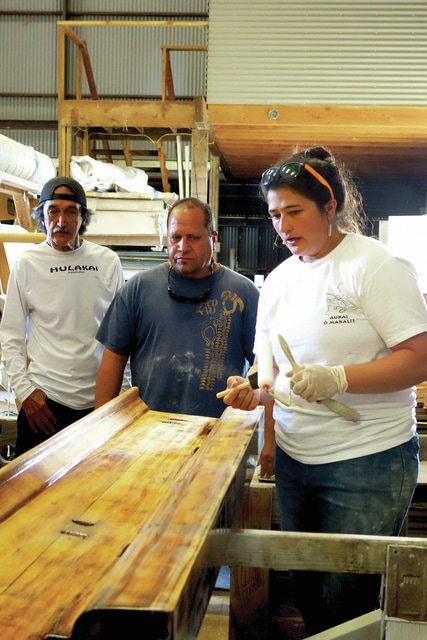The program allows Pwo Navigator Shorty Bertelmann, who sailed with Papa Mau on the first Hokulea voyage, to transmit his knowledge to the existing crew members and help them advance and get to leadership levels,” said Keala Kahuanui, program coordinator.
 Chadd Paishon and Pomai Bertelmann
Chadd Paishon and Pomai Bertelmann The land crew will learn about three different practices. The first is Ai Pono (eat healthy). “A few years ago at the Ku Aina Pa (garden educators program), Chadd noted that our ancestors were able to traverse this ocean and asked, ‘Can we provision one canoe on one voyage?’” Kahuanui said.
This question set Malaai Garden’s Director Amanda Rieux and Waimea Middle School students on a quest to feed the canoe crew by creating healthy, storable foods produced from the garden. To prepare for the voyage to the Northwest Hawaiian Islands, the land crews will need to provision the canoe for a 30-day voyage with a 14 voyaging crew.
“This is a huge effort to have the time and resources to intentionally provision our canoes better,” Kahuanui said. “If we provision the canoe for 30 days that’ll be a good test, good data collection. From Hawaii we can go any direction and reach land in 30 days.” But the hope is the voyage will continue on land after the canoe has returned.
“We are working together in the name of a voyage, but also in the name of the continuous voyage of being a little island in the middle of the ocean. We are creating the processes and protocols on how to preserve foods so that when we have an influx of weather and we have these emergency kits, perhaps we’re not running to the store. There’s a lot of work to do,” she said.
 Keala Kahuanui
Keala Kahuanui “Sometimes we get caught up in the physical side, training, planting, and we forget there’s another side: the spirit. It’s making sure that everyone understands that as much as it’s a physical journey, the spiritual journey is also a part of us and for us. It’s one and the same. It’s never separated,” Paishon said. “When we start to talk about ceremony and protocol, it’s the same with everything we do. When we’re putting our plants in the ground it’s the intention you plant with, the spirit you plant with. That’s really what hanai is — that connection.”
The third practice is Pilina Kaula, meaning closely connected strands. Cordage was crucial to the voyaging canoe and was a prized gift. Olona, which is being grown at Ho’ea (the canoe garden in Kohala), provided durable strength far superior to any available European cordage, and literally held the voyaging canoes together.
“They’ll learn to propagate the plants and make cordage from them that will be used in our ceremonies upon arrival and departure. Pilina Kaula is the physical side of Hanai Waa, creating connections. Pilina, (closeness) to the cordage, to the moku (island), our waa and the islands that we’re going to,” Kahuanui said.
As part of the grant, students from 11 partner schools on Hawaii Island will be trained in the near future after their teachers complete training that started recently. In North Hawaii, participants will come from Kanu o Ka Aina, Alo Kehau o ka Aina Mauna, Punana Leo o Waimea, Kohala Elementary and Middle School and Laupahoehoe Public Charter School.
“Our schools are really excited. The movement of the waa creates that excitement and the desire to participate. For those who are not voyagers, this allows them to engage and provide their resources and expertise. Everybody has a piece of the puzzle,” she said.
The land crew will have the chance to experience “Makalii magic” and get to experience authentic learning. “Makalii is very good at creating relationships and this will set that precedence. The schools are encouraged to come to the canoe and build a relationship. The hull space is where their food will get stored. To see that, they will realize that what they’re doing is affecting more than them and their classmates. It’s helping to perpetuate and sustain our traditions,” Kahuanui said.
While there is a foundation of knowledge and experience to draw from, for the canoe to continue to voyage it requires everyone to find and share their strengths and work together. “The beauty of the training is that we’re not supposed to have all of these already set. It’s a process and we’re going to learn from each other. We’re going to build upon our strengths and that’s the beauty of voyaging. You’re going to depend on each other’s strengths and challenges to reach our destination,” she said.
Hanauna Ola is the next phase in a long journey to recapture the practices that made it possible for the ancestors to thrive. “We are so fortunate to live in this day and time. All the other layers have been built up and now we have this layer we can work on and start to lay out the foundation for the next generation of voyagers as a template of what we have done. What Chadd and Shorty are doing is sharing their knowledge with the next generations of canoe crew and laying down a path for future generations to follow,” Kahuanui concluded.



 RSS Feed
RSS Feed
